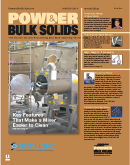If a batch mixer is required to handle several diffe rent formulations, it is very often necessary that the machine is easy to clean between batches to ensure individual batch integrity or to avoid the potential problems of batch to batch contamination. These issues often arise in pharmaceutical applications where batch integrity can be paramount, and in multi-product food manufacturing facilities where ingredients used in the same machine can vary from, say, powder soup mixes to cake mixes. In all cases, the key to the question of easy clean out is, in the first instance, the initial machine design configuration, and second, ease and efficiency of operator access.
rent formulations, it is very often necessary that the machine is easy to clean between batches to ensure individual batch integrity or to avoid the potential problems of batch to batch contamination. These issues often arise in pharmaceutical applications where batch integrity can be paramount, and in multi-product food manufacturing facilities where ingredients used in the same machine can vary from, say, powder soup mixes to cake mixes. In all cases, the key to the question of easy clean out is, in the first instance, the initial machine design configuration, and second, ease and efficiency of operator access.
Mixer Selection
The machine design should start at the initial sales inquiry stage where the type of batch mixer to be offered by the machine supplier is considered against the application. There are several different types of batch mixer including horizontal mixers, vertical mixers and tumbling blenders, and within each type of machine, there are also variations of mixing element and geometry that will be best suited to the application. It will depend upon the knowledge and experience of the sales person to ensure that the most suitable machine is offered.
Part of the consideration in this initial machine selection stage will be an evaluation of the need and frequency of cleaning. Various methods of cleaning are employed across the different industries and these include dry cleaning using vacuum equipment, brushing, scraping, and air jet blowing, although, in the latter case, careful attention to venting and filtration will be necessary to avoid the unwanted escape of dust. Wet cleaning methods will include high-pressure water or steam cleaning via fixed Clean in Place (CIP) nozzles, or hand held lances. If however the machine requires wet cleaning between batches, consideration will need to be given to drying the mixer surfaces before the next batch is loaded since this will often lead to the unwanted build up of the product as the dry powders stick to the wet surfaces. For this reason, cleaning between batches is more often confined to dry cleaning using vacuum, brushes or scrapers, or a combination of all three. Wet cleaning tends to be more usually employed either at the end of a shift or campaign or within automated processes.
Horizontal vs Vertical Mixers
Considering the different types of batch mixer with regard to easy cleaning, Horizontal mixers generally, and because of their design and configuration, offer perhaps the best potential for good access into the mixer vessel for either dry or wet cleaning. Vertical mixers can sometimes be less favorable than horizontal machines due to the limited access that can be provided, particularly to the lower end of the conical section. Rotating Blenders present relatively uncluttered internal surfaces, and can sometimes, therefore, require less effort to clean, but as with vertical mixers, access may be rendered more difficult by their shape depending upon whether the machine in question has a rotating drum type, or is a double cone type blender.
Once the machine type has been decided, then the question of access for cleaning can be considered. Generally speaking the greater and simpler the access, the more efficient the cleaning activity will be.
Regardless of the machine type, access to the internal product contact surfaces will usually be afforded via doors or hatches of one type or another. For simplicity and ease of operator access, the doors should ideally be side hinged and should be secured via manual catches rather than nuts and bolts. Nuts and bolts can be difficult, time-consuming, and invariably will not be fully replaced after being removed. Also, and for ease of operation, doors should be either counterbalanced or lift assisted in some other manner using, for instance, gas filled struts.
Easy Clean Features
For most types of mixers, it is a fundamental requirement that the doors or access hatches be safety interlocked to ensure that access cannot be permitted unless or until the machine is rendered safe, and that there is no possibility that any rotating mixing elements can be started while operator access and cleaning is taking place. This security is in most cases best achieved using a key type interlock with a separate rotary switch built into the mixer control panel that requires the key to be removed from the rotary switch before transferring to and unlocking the door, thus ensuring a built-in time delay that will allow the machine to fully run-down to stationary before the door is released.
Gardner K Series Cantilever Mixer with key-operated safety interlocks.Cleaning access doors should be designed and positioned according to both the configuration of the machine and its location within the process line.
Horizontal batch mixers offer the greatest potential for operator access either through safety interlocked top doors or side access doors, or if the machine incorporates a cantilevered agitator, via a pivoted end door, or for maximum access, a combination of all. Vertical mixers will generally have access doors in the top covers of the machine, and may also have side access doors in the conical mixer bodies, although the shape of the cone sometimes makes this a little more difficult to achieve. Rotating blenders will often be fitted with access doors in the blender bodies.
Depending on the application, access doors fitted to the sides of mixer or blender bodies may be internally flush fitting. This expedient will reduce the tendency for product hang-up after discharge.
In all cases, where access doors are located in the body of the mixer vessel, as opposed to the top cover, then the proximity of adjacent steelwork, or other equipment needs to be considered to ensure that access to the mixer internal surfaces is not hindered.
In the design and positioning of all types of access doors, care should be taken to ensure that adequate access is afforded to reach and see all of the internal product contact surfaces of the batch mixer. Areas that are sometimes overlooked are the back of mixing blades on low-speed low energy mixers with spiral type agitators, the feet of mixing shovels on high-speed plough type mixers, and the underside of screw flights in vertical mixers. Careful design will avoid these “shadow” areas.
With horizontal mixers, in particular, attention should also be given to the agitator shaft end seals. Depending upon the application, careful cleaning of the shaft seal areas will be important since product can lodge in this area and can, therefore, be a cause for concern. The standard sealing arrangement will incorporate packed gland assemblies which may also be air purged. This type of seal will require regular maintenance attention to ensure that they stay in good condition and perform as they are intended, i.e. don’t leak. Alternative sealing arrangements may be fitted that will require less attention, but usually at a higher initial price. These will include lip seals, semi-mechanical seals with polymer elastomer seal mechanisms and traditional mechanical seals with metallic rubbing faces. Again, the most suitable type of seal will be recommended at the quotation stage depending upon the application.
In summary, the key features that will make a batch mixer easier to clean between batches will be a combination of the following:
- The most suitable mixer type for the given application
- Well designed and carefully positioned access doors or hatches
- Shaft seal selection
- Method and type of cleaning to be employed
For more information contact Kemutec, sales@kemutecusa.com or call Kemutec at 215 788-8013
Gardner 18,000L HE Ribbon Mixer